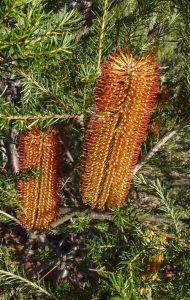Summary of an article originally published on the Royal Botanic Garden Sydney website, published 9th November 2022, written by Patrick Whiteley, titled: ‘Seeds of hope for Banksia restoration projects’
A plant seed typically contains an embryo, that develops into a new plant, and some food to support germination until the seedling can produce its own food. However, seeds may also contain microbes, like fungi and bacteria, that have no harmful effects but may actually be beneficial for plant growth!

These microbes that live in plant tissue without any harmful effects on the plant are “endophytes.” What we know about endophytes has come mainly from research into agricultural plants, such as cereal crops like wheat and barley. Over recent years, researchers have found that almost all plants contain at least one endophyte.
Allison Mertin, a researcher at the Australian Institute of Botanical Science at the NSW Botanic Gardens, has begun looking at how endophytes work in native plant communities. She has been studying endophytes in Australian native Banksia species, focussing on Banksia serrata and Banksia ericifolia, both well-known species around Sydney. She has found that fungi that grow on the outside of Banksia cones also grow inside the seed. One question that immediately comes to mind is how these endophytes get into the Banksia seeds. Plant scientists know there are a number of ways endophytes can enter plants. Because the fungi Allison found were not present in every seed, she thinks they might be coming in through particular pollinators.
The relationship between endophytes and plants is not very well understood. This research into firstly, what microbes are in seeds and, secondly, what they do there, will help us understand better how seeds function. This knowledge, in turn, could make restoring Banksia species, for example, into Australia’s natural ecosystems more successful. Allison’s research is helping us realise collecting seed for revegetation is not just about the genetic diversity of the plants but also about the diversity of the microbial community inside the seeds. As endophytic fungi in seeds may play a role in promoting plant health, checking that Banksia seed used in restoration projects contains the fungi Allison has found might lead to greater success in revegetation efforts.
